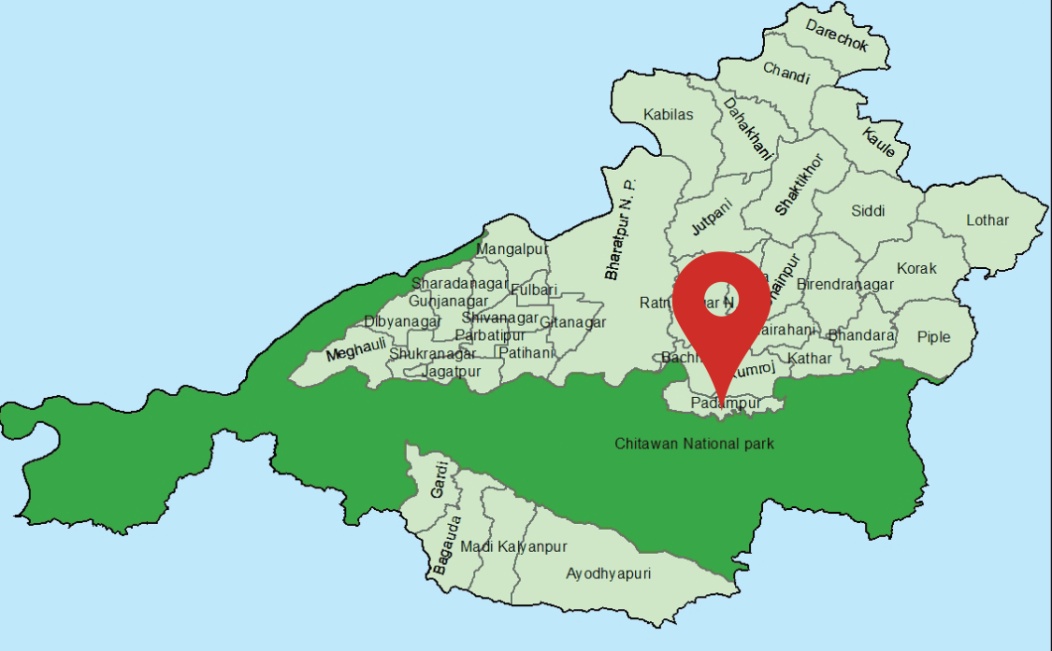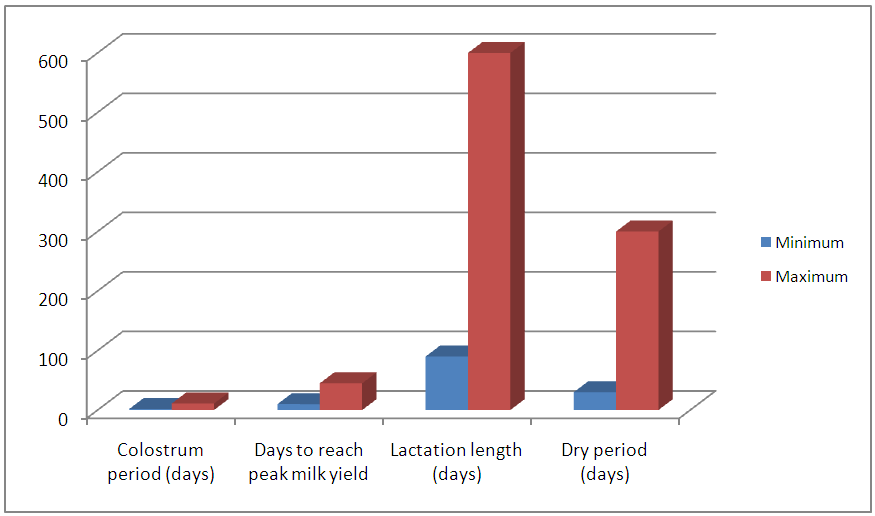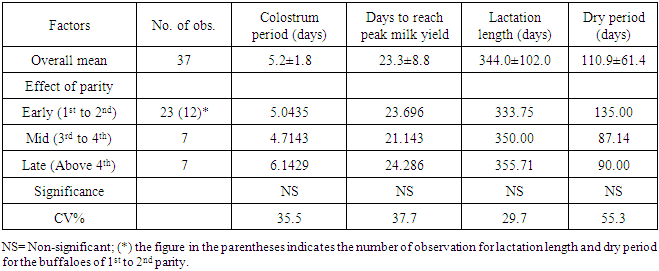-
Paper Information
- Next Paper
- Paper Submission
-
Journal Information
- About This Journal
- Editorial Board
- Current Issue
- Archive
- Author Guidelines
- Contact Us
International Journal of Agriculture and Forestry
p-ISSN: 2165-882X e-ISSN: 2165-8846
2017; 7(6): 140-144
doi:10.5923/j.ijaf.20170706.04

Effect of Parity on Lactational Efficiency of Murrah Crossbred Buffaloes (Bubalus bubalis L.) in Central Nepal
Dikshit Poudel1, Nirajan Bhattarai1, Krishna Kaphle2, Saroj Sapkota3, Milan Kandel1
1Agriculture and Forestry University, Rampur, Chitwan, Nepal
2Institute of Agriculture and Animal Science, Tribhuvan University, Sanepa, Lalitpur, Nepal
3Nepal Agricultural Research Council, Khumaltar, Lalitpur, Nepal
Correspondence to: Nirajan Bhattarai, Agriculture and Forestry University, Rampur, Chitwan, Nepal.
| Email: |  |
Copyright © 2017 Scientific & Academic Publishing. All Rights Reserved.
This work is licensed under the Creative Commons Attribution International License (CC BY).
http://creativecommons.org/licenses/by/4.0/

With the aim of determining effect of parity on different traits related to lactational efficiency, Kalika Municipality, Padampur of Chitwan District was purposively selected and field assessment was conducted from April to August, 2017. Primary data were collected through direct interview with 37 buffalo rearing farmers using closed ended semi-structured questionnaire. Various traits related to lactational efficiency including colostrum period, days to reach peak milk yield, lactation length and dry period were taken under consideration. One way analysis of variance was performed to assess the effect of parity on the traits considered using GenStat4. Findings of present study revealed that overall mean of colostrum period, days to reach peak milk yield, lactation length and dry period were 5.2±1.8 days, 23.3±8.8 days, 344.0±102.0 days, 110.9±61.4 days, respectively which were obtained with ranges 2-11 days, 10-45 days, 90-600 days, and 30-300 days, respectively. Meanwhile, parity had no significant effect on major lactational traits considered under this study. However, buffalos with mid parity (3rd - 4th) were superior in terms of colostrum period, days to reach peak milk yield and dry period. Thus, it is concluded that parity of buffaloes was not an important source of variation with respect to major lactational traits. However, further research should be carried out considering larger sample size and wider agro-ecological domain is recommended for the validation of present findings.
Keywords: Production Traits, Murrah, Parity, Chitwan
Cite this paper: Dikshit Poudel, Nirajan Bhattarai, Krishna Kaphle, Saroj Sapkota, Milan Kandel, Effect of Parity on Lactational Efficiency of Murrah Crossbred Buffaloes (Bubalus bubalis L.) in Central Nepal, International Journal of Agriculture and Forestry, Vol. 7 No. 6, 2017, pp. 140-144. doi: 10.5923/j.ijaf.20170706.04.
Article Outline
1. Introduction
- Riverine Buffalo (Bubalus bubalis L.) is the major milk contributing dairy species enhanced with multiple utilities in Nepal. The river water buffalo is the type that is more suitable for milk production. They are second most common source and occupy major rank of milk source in many countries (Sahin et. al, 2016) and contributes about 65% and 54.4 in terms of milk and meat (DLS, 2016). Murrah crossbred buffaloes that have important phenological and adaptation trait to thrive in adverse climatic condition were the subject of present research. Buffalo contributes with milk, meat, manure for crop production and draft power in plain areas. Majority of households raise at least one buffalo for milk and manure production and sell male calf or mature male for family income. In road accessible areas, buffaloes are the main contributor of urban milk supply (Osti, 2007). Average milk production (305 days lactation) is 1372 kg, 1048 kg and 1031 kg respectively for the Murrah, Lime and Parkote breeds. (FAO, 2005). But, buffalo population and milk production is increasing as compared to previous years. 5,167,737 buffaloes were reported in 2014/15 while 5,168,809 buffaloes in 2015/16. Similarly, 1,168,006 Mt milk production in 2014/15 and 1,210,441 Mt in 2015/16 was reported in Nepal according to the data provided by Ministry of Agriculture Development, 2015/16. Milk production trait is closely related with the parity of animal. Different lactational trait that defines total productivity of buffalo farming are first day milk after parturition, colostrum period, days to reach peak milk yield, peak milk, lactation length, calving interval and dry period. Major considerations in this study were colostrum period (days), days to reach peak milk yield, lactation length (days) and dry period (days). Lactation milk yield is most important parameter of dairy buffalo. Factors which affect the lactation yield would also influence the lactation length in buffalo (Chaudhary, 1992). Lowest production per lactation is achieved at the first lactation. With advancing age, milk production increase to reach the maximum at the 3rd, 4th lactations, then starts again to decrease (Velea, 1999). Peak yield had good correlation with total milk production (r = 0.448). The results indicated that peak yield could be a reliable measure in predicting livestock productivity (Kalyankar, 2003). Colostrum is considered to be “liquid gold” as it contains maternal antibodies along with high energy source, protein, vitamins (A, E, D, B) and minerals (Georgiev, 2008). The fat, lactose, protein, and dry matter content of water buffalo milk are higher than that of cow milk (Sahin et. al, 2016). The iron content is 10 to 17 times higher in colostrum than in normal milk (Kuralkar and Kuralkar, 2010). A milch animal is supposed to be economical if she has shorter dry period and lower colostrum period for higher economic return. Thus the dry period is the important economic traits that determine the milk production efficiency of buffaloes (Sanker et. al., 2014).This paper mainly aims to assess the effect of parity on major milk yielding traits in Murrah Buffalo in Central Nepal.
2. Materials and Methods
- Study location:The assessment was conducted at Kalika Municipality, Padampur of Chitwan District which was purposively selected. Padampur is pocket for buffalo production as suggested by District Livestock Service Office, Chitwan.
 | Figure 1. Map Showing study location; Padampur, Chitwan District, Nepal |
3. Results and Discussion
- The effects on major lactational traits were analyzed and the findings were summarized as follows.Colostrum PeriodOverall mean of colostrum period in Murrah Buffalo was obtained as 5.2±1.8 days which were obtained with range 2-11 days. Coefficient of variance was found to be 35.5%. Colostrum Period of buffalo with late parity was obtained highest i.e. 6.1 days and of mid parity was obtained to be lowest i.e. 4.7 days as presented in table 1. Meanwhile, parity has no significant effect (p>0.05) on this trait. However, buffalo in mid parity i.e. lower colostrum days was found superior in terms of colostrum period. Findings of Smijisha and Kamboj (2012) suggest that colostrum in Murrah buffalo calves reared under different management practices is up to 5 days fed at the rate of 1/10th of body weight using pail. Lower the number of colostrum days, higher will be the economic return.
|
 | Figure 2. The range values (minimum and maximum) of lactational traits; colostrum Period, days to reach peak milk yield, lactation length and dry period |
4. Conclusions
- Based on the findings of present study, it can be concluded that parity was not an important source of variation with respect to major lactational traits considered under this study. However, buffalos with mid parity (3rd - 4th) were superior in terms of colostrum period, days to reach peak milk yield and dry period. Further research should be carried out considering larger sample size and wider agro-ecological domain for the validation of present findings.
ACKNOWLEDGEMENTS
- We would like to express our special thanks to Department of Animal Breeding and Biotechnology, Agriculture and Forestry University; Prof. Dr. Naba Raj Devkota, Director, Directorate of Research and Extension; Asso. Prof. Dr. Kalyani Mishra, Assistant Dean (Academic) of Faculty of Agriculture, AFU, Rampur. We would also like to express our gratitude to Prof. Dr. Mohan Sharma; Department of Animal Breeding and Biotechnology, AFU, Rampur; IAAS, Tribhuvan University and District Livestock Service Office, Chitwan. We are indebted to Colleagues, Padampur Dairy Co-operatives Pvt. Ltd. Padampur, working staffs, the household and famers who co-operated with us during our study.
 Abstract
Abstract Reference
Reference Full-Text PDF
Full-Text PDF Full-text HTML
Full-text HTML